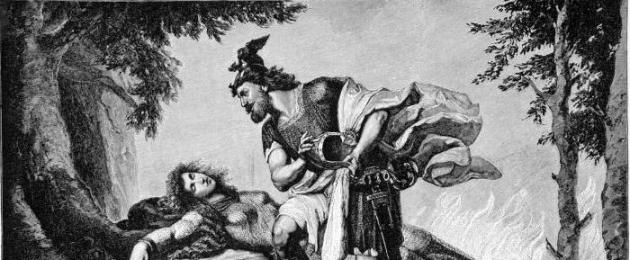Who is Siegfried? The mythology of the Scandinavians, what does it say about him? You will find answers to these and other questions in the article. Siegfried (Sigurd) is one of the most important characters in the Scandinavian-Germanic epic and mythology. It is he who is the main character in the "Song of the Nibelungs".
Mythology
The characters are amazing. Scandinavian Odinism is a part of ancient Germanic mythology. The basic source of information about him are the works "The Younger Edda" (prosaic) and "The Elder Edda" (poetic) by S. Sturluson of the 12th century AD. e.
Around the same period, in the Acts of the Danes, the Danish chronicler Grammar Saxon transmits many legends. Valuable information about the mythology of Ancient Germany can be found in Tacitus' Germany.
The origin of the legend
So who is Siegfried? What is said about him in mythology? The question of the starting point of this epic personality has not yet been fully clarified. Some wanted to see in him an epic glimpse of the memories of Arminius (the historical prince of the Cherusci), who defeated Var. It is most likely that Siegfried, next to Hagen and Brünnhilde, is the bearer of the mythical central motive of the saga, to which other, partly historical, details later joined.

The saga is based on a common Indo-European myth (demonic or divine), which is interpreted in different ways: some find in the hero's struggle against enemies a mythical expression of the change of night and day, darkness and light, others - summer and winter. Therefore, Siegfried is identified with Thor (Donar), then with Freyer. Brünnhilde, depending on this, is understood either as terrestrial vegetation, or as spring, or the sun. There are also scholars (Heinzel, Fischer) who, in the legends about Siegfried, see the result of the fusion of several legends and myths.
The Song of the Nibelungs is great. The form in which the basic motive was preserved in it, he received on the Rhine from the Franks. From here, not earlier than the 6th century, he passed to other Germanic peoples, including Scandinavia. Here the name Sigfrid, incomprehensible to people, was replaced by the name Sigurd. There were also richly developed legends about his father, Sigmund, and his ancestors, which were available on the mainland. "The Saga of the Völsungs" connects the hero's family with Odin - the supreme deity.
Siegfried
What is Siegfried in mythology? He is the son of the Frankish queen Sieglinde and King Siegmund, a prince from the Lower Rhine. Siegfried - the conqueror of the Nibelungs, who captured their treasure - the gold of the Rhine. He has all the traits of an epic ideal hero. He is courteous, brave and noble. Honor and duty are above all for him. In "Song" his extraordinary physical strength and attractiveness are constantly emphasized.
Plot
The "Song" we talked about above is an epic medieval poem written by an unnamed author in the 12th-13th centuries. She is among the most famous epic writings of mankind. It tells about the relationship of the Germanic tribes of the 5th century and about the desire to establish family ties with the Huns, who at that time were entrenched in Eastern Europe and threatened the banks of the Rhine.
The plot of the poem is based on the marriage of the Frankish legendary hero - "dragon-slayer" Siegfried to the Princess of Burgundy Kriemhild, his death due to the quarrel between Kriemhilda and Brunhilde - the wife of her brother Gunther. An important point is also the revenge of Kriemhilda with the help of the Hun ruler Etzel to his fellow Burgundians for the elimination of her first beloved husband Siegfried. The catalyst for all actions is the mysterious third force in the person of the omniscient and omnipresent villain Hagen.
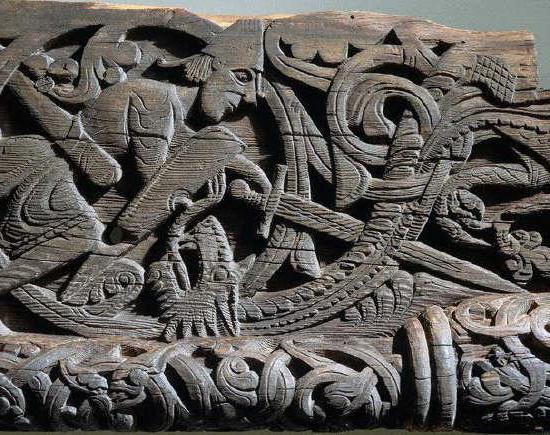
Dragon conqueror
What are the main feats of Siegfried? In ancient times, Queen Sieglinde and King Sigmund ruled the lower Rhine, in the city of Xanten. They had a son, Siegfried. From childhood, the boy was distinguished by strength, beauty and courage. Already in his youth, he showed unprecedented heroism.
One day young Siegfried came to visit the blacksmith Mima, an experienced old artisan. He saw how the master and his assistants were working at the anvil, and wished to become a disciple of the venerable Mima. The blacksmith kept it with him. The next day, the blacksmith brought his newly-made pupil to the forge and ordered him to hit the workpiece with the heaviest hammer.
Siegfried fulfilled his wish, and the anvil went into the ground, and the red-hot workpiece shattered into pieces. The assistants were surprised, and the disgruntled blacksmith refused to teach Siegfried. But the young man told the master that he would moderate his strength, and the blacksmith kept him with him.
Soon Siegfried began to quarrel with the apprentices, and the blacksmith regretted his decision. The henchmen threatened to leave the forge if a newcomer remained. Then the owner decided to get rid of Siegfried. He sent him into the forest to harvest charcoal. And a mighty dragon lived in the forest under a linden tree. The master thought that the monster would swallow the young apprentice.
And so Siegfried went into the forest and began to fell trees. He did his job, lit a fire, and he sat down on a stump and watched the fire. Suddenly, a huge monster with a huge mouth crawled out from under the roots. The dragon approached Siegfried and began to sniff. Siegfried immediately grabbed a burning tree from the fire and began to beat the dragon with it until it fell down dead.
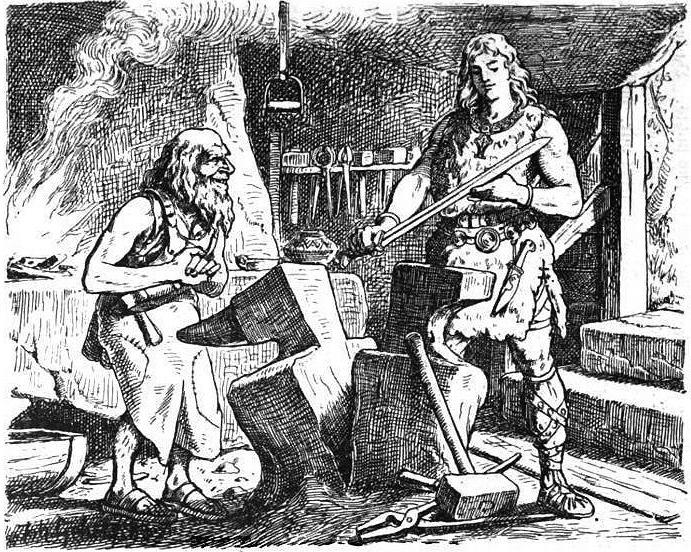
Steaming dragon blood flowed in a stream. Siegfried dipped his finger into it and saw that the finger was horny so that no sword could cut it. Then he undressed and bathed in this blood. Siegfried became all horny, except for a small area between the shoulder blades on his back, where a linden leaf fell. Then the young man dressed and went to the castle of his parents.
Division
Consider another major feat of Siegfried. He did not stay at home, often traveled in search of adventure and performed many miracles, as he was very strong. Once Siegfried found himself in the forest, where he saw how noble men carry an impressive treasure out of the cave. These were the treasures of the Nibelungs. Siegfried had never seen such wealth before.
Shilbung and Nibelung - two kings were going to share the treasure. Siegfried approached them. The kings greeted him and asked him to share the treasures honestly. They had so much gold and precious stones that they could not be taken away in a hundred carts. As a reward, the kings presented Siegfried with the Balmung sword, which belonged to the Nibelungs.
Siegfried began to divide the treasure, but each of the kings decided that he had been cheated. The knight did not have time to complete the section, as the kings attacked him. But Siegfried destroyed the debaters with the glorious sword Belmung.
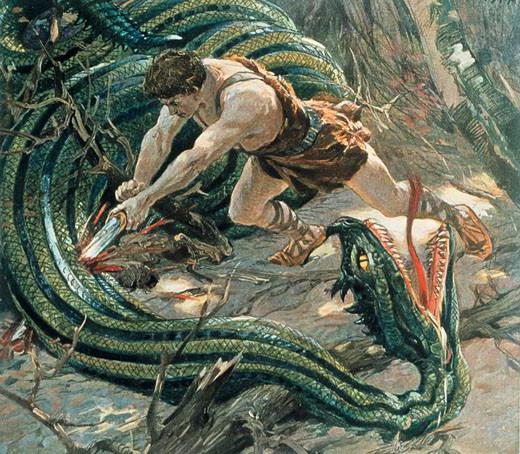
The powerful dwarf Alberich saw this. He decided to avenge the death of his masters. The dwarf wore an invisibility cloak, giving the strength of twelve warriors. He threw it over himself and rushed at Siegfried. The knight defeated the dwarf in a fair fight, then took the invisibility cloak from him and took all the treasures of the Nibelungs.
So Siegfried overcame the overseas knights, became the ruler of the land of the Nibelungs and the owner of their treasures. Siegfried ordered to take the treasure back to the cave, the dwarf Alberich assigned him to guard and took an oath from him to be his loyal servant.
Brunhilde
So you know what the mythology says about Siegfried. Who is Brunhilde? She is the heroine of Scandinavian-Germanic mythology. Brunhild or Brunhilda ("duel") is the most beautiful and warlike Valkyrie who challenged Odin: she gave victory in battle to someone who was not prepared for her by God. The Almighty, as punishment, plunged her into sleep and sent her to earth, where Brunhild was supposed to sleep on the Hindarfjall hill, surrounded by a wall of fire.
Only Sigurd (Siegfried in the Germanic epic), the famous hero who defeated the dragon Fafnir, could break through the raging flames. What does the legend of Siegfried and Brunhild say next? Siegfried woke up the beautiful Brunhilde, and promised to marry her. He left the ring of the dwarf Advari as a pledge to the belligerent beauty, not knowing that a curse hung over this ring.
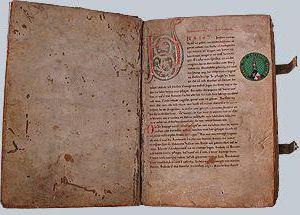
The witch Grimhild gave Siegfried the nectar of oblivion, and he, forgetting about his bride, married the witch's daughter, the beautiful Gudrun (in the Germanic legends of Kriemhild). When his memory returned to him, Siegfried's heart was filled with sadness, shame and suffering.
Meanwhile, Krimhilda's brother, the Burgundian king of the Burgundians (in Germanic legends, Gunther), wooed Brunhilde. But the Valkyrie vowed to marry someone who passes through the wall of fire that surrounds her, which only Siegfried could do.
Siegfried expressed his willingness to help Gunther. During the marriage trial, he changed his guise with Gunther and went through the fire instead of him. Brunhilde was forced to become Gunther's wife. When the deception was revealed, the embittered Brunhilde demanded that her husband kill Siegfried. As a result, Gunther and his brother Hagen fatally wounded Siegfried while hunting. Traitor Hagen, aiming between the shoulder blades, threw a spear at the unarmed hero. He managed to get exactly to the place that was once covered by a fallen linden leaf.
Dying on his deathbed, Siegfried called his beloved Brunhilde. The beauty could not bear the remorse and killed herself in order to be near her lover even in the grave.
Only after the death of Siegfried and Brunhilde they found peace in love, which had previously been destroyed by vile intrigues. And the anathema of the dwarf Andvari, along with the inherited ring, passed to Hagen and Gunther. Later they both died a painful death, but they did not reveal the secrets of the ill-fated treasure of the Nibelungs.
Symbolic meaning
The killing of the dragon Fafnir by Siegfried can be interpreted as an act of a cultural hero gaining the upper hand over the forces of chaos. In a large number of legends that have a deep symbolic meaning, the dragon appears in this very meaning - the primitive enemy, the battle with which is the highest test.
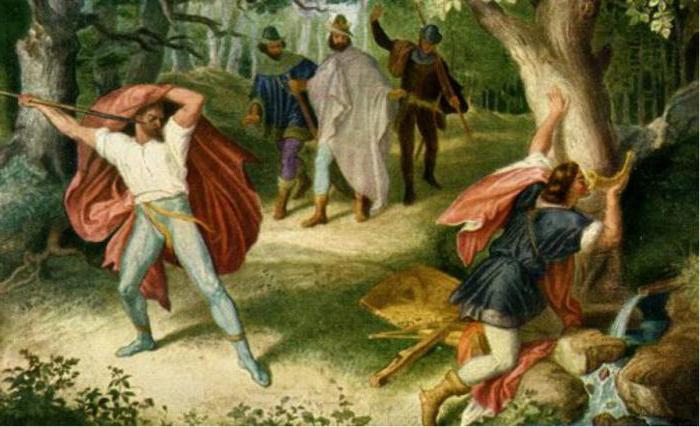
Thus, the patrons of chivalry, the holy Archangel Michael and the righteous George, are depicted at the moment when they slay the monster. The dragon symbolizes the calamities that plague a person or country.
The plot, when Siegfried wakes up Brunhilde, is a symbol of seeking the path of the soul and freeing it from prison.
The meaning of the legend
So, you already know the Siegfried characteristic. The myth about him became one of the main texts for the Germans, and its different versions date back to the pagan period. For Germany, Siegfried is a cult figure. In the attitude of the people of this country, he is presented as the ideal of balance of body and spirit.
With the help of the legend of Siegfried, images were created that have become archetypal in world culture. Ancient German-Scandinavian legends in the 19th and 20th centuries occupied an important place in the cultural consciousness of Europeans, and became its significant component.
- In contact with 0
- Google+ 0
- OK 0
- Facebook 0

